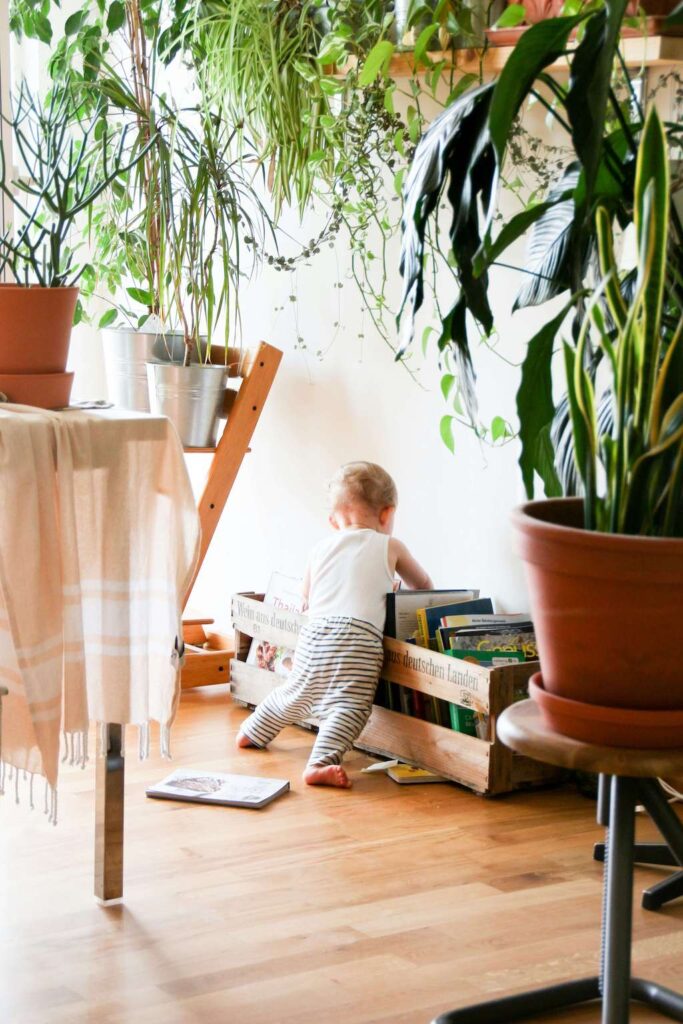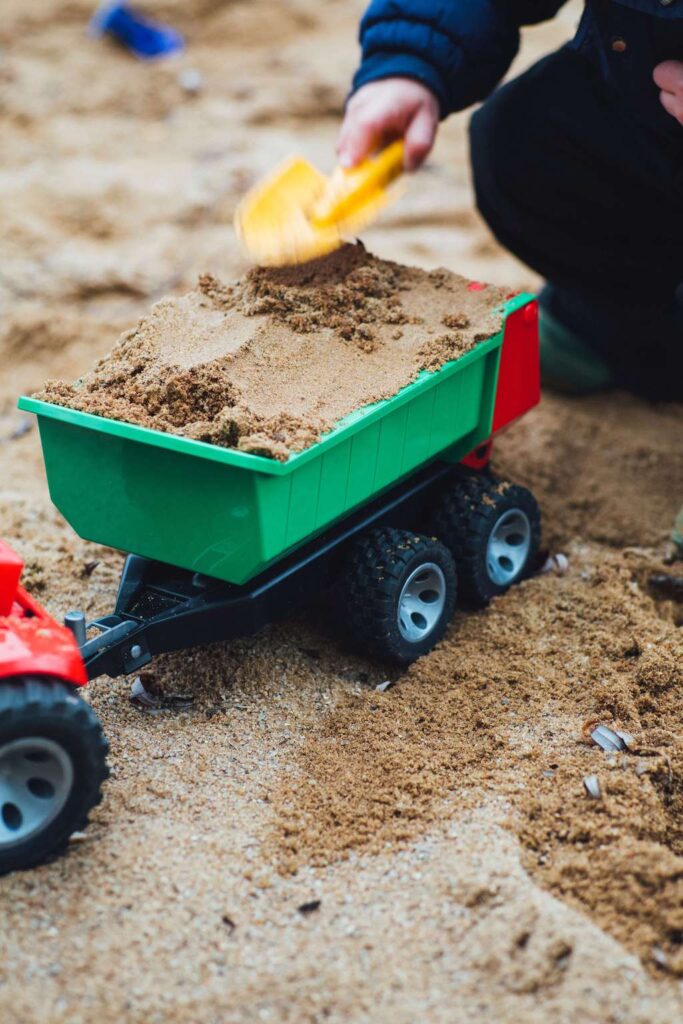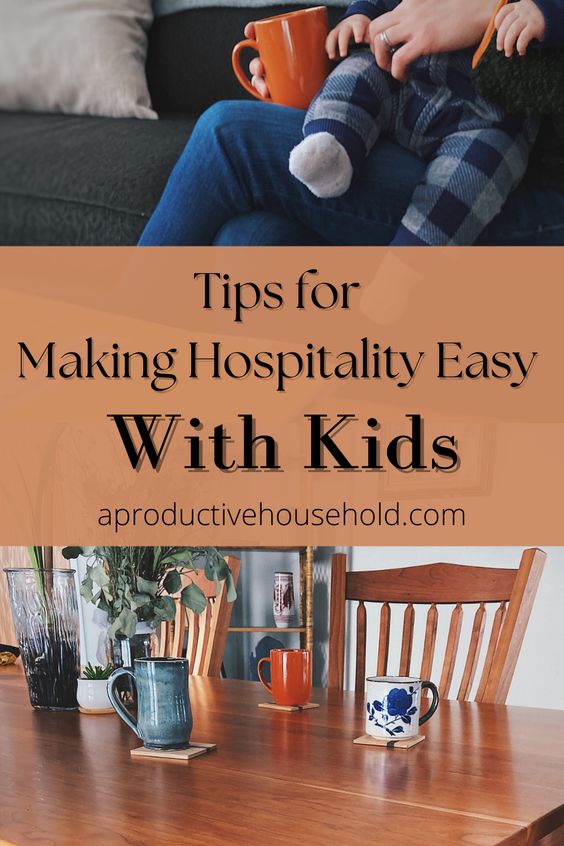Family Routines – 5 Benefits of Daily Rhythms for Our Children
Having consistent daily, weekly, monthly, and even yearly rhythms and family routines for has created in our home security, peace, and the ability for us to accomplish a lot of goals together that we would not have been able to otherwise! Implementing systems and routines can sound overwhelming at first, but if you take it one step at a time, it’s very do-able!
Systems and routines help our home to run without a lot of stress, worry, or constantly having to think through problems in the home. This frees up brain space for us to really enjoy being with our kids, cook healthy meals, spend time together as a married couple, and so much more. And with two toddlers and a baby, it is absolutely necessary for us to have a sense of order, or the house would quickly become a puddle of chaos!
Pin this Post for Later!

What are Family Routines?
Routines look different for every family, and they even look different for each family depending on the season. While many of our family routines (like a consistent family dinner time) stay the same, there are also parts of our daily routine that can change every few months or so (like babies’ nap times or outdoor chores).
Family routines can involve the entire family (such as meal time) or just some of the family (like read aloud time).
In the end, family routines are the everyday routines and daily activities that provide a sense of consistency in the home AND help the home to function properly – without having to re-create your plan every single day.
And family routines don’t just have to include your daily schedule. A consistent routine with weekly rhythms, like grocery shopping, church, or regular hospitality are also necessary to keep things moving along smoothly!
Even monthly and yearly routines, like vacations or more occasional household tasks, bring a sense of peace to the entire family when everyone has an idea of what to expect.
What are Some Common Routines for Young Children?
With young children, it’s especially important to have predictable routines. It’s important for them, because they need to know what to expect. And it’s important as parents, because the younger they are, the more responsibilities fall on us.

Having simple daily routines and daily expectations allows us to know exactly what we need to do and creates simple processes for the things to actually get done! Overall, this means a calmer household and a lot less stress for everyone.
So what are some regular, common routines for young children?
Morning Routine
A predictable morning routine is probably the best way to start the day off on the right foot.
For us, our normal routine in the morning includes everyone having a consistent wake time every day. We get up before our kids, so by the time they get up at 7am each day, we’re (usually) feeling organized, there’s wood in the fire (in the winter), the bed is made, and one of us is usually starting breakfast. This is essential for our family, so that we feel feel like we’re on top of the daily tasks, rather than letting the kids wake us up and starting off the day feeling behind.
A morning routine might include getting everyone dressed (or making sure that they are equipped to get themselves dressed), making breakfast, opening blinds, morning devotions, and cleaning the kitchen.
Story Time
Reading is a great way to fill time for anyone! Reading aloud is definitely my go-to whenever things are getting a little out of hand, the kids start to get irritable and need some extra love, or if I just want to sit down for a minute.
Although we intersperse reading time throughout the day, the kids love being able to count on their regular reading times, which, at minimum, include right after naps and before bed.
See our favorite wholesome children’s books here.
Snack Time
When in doubt – snacks! Regular snack times help balance everyone’s blood sugar, provide a sense of structure, and, of course, nourish the kids! Just remember that while nourishing snacks lead to healthy, happy kids, processed snacks and junk food will actually make kids more whiny and irritable and overall do not lead to healthy and happy homes.
Some of our favorite snacks include cut fruits and vegetables, cheese, nuts and seeds, peanut butter, tortilla chips, and meat sticks.
Outdoor Time
There are so many benefits to having regular outdoor times! Not only are there tons of health benefits to getting fresh air, sunshine, and physical activity, but it also helps kids learn creativity and gives them a chance to explore.

Whenever possible, we love to implement constructive activities into our outdoor time, like taking care of the chickens, watering the garden, or even simple tasks like getting the mail. This gives everyone a sense of accomplishment and responsibility rather than just “passing time” outside. Even if you don’t have a big yard, you can still create structured projects and activities outside, like herb gardens, visiting neighbors, or going on a nature walk.
1000 Hours Outside has so many amazing resources and ideas for getting kids outdoors!
Free Time
Just because you have a predictable daily routine doesn’t mean that there can’t be any free time! In fact, free time is a necessary part of our kids’ regular routines.
During “free time”, they have the opportunity to figure out how to entertain themselves rather than us telling them what to do. There are boundaries (for example, they need to be able to clean up their messes, and they have specific items that they can play with), but within those parameters, they can do what they want. We’re always amazed at the creative ideas they come up with!
Nap Time/Quiet Time
A regular, consistent nap time or quiet time means that everyone is well rested. At our house, everyone naps (or does quiet time) at the same time in the afternoon. They all look forward to this time, and it gives me a predictable 2+ hours each day where I can plan on focused time to get things done in a quiet house.
Bedtime Routine
Having the same bedtime routines every day means that there aren’t 10 requests for water, or 5 asks for another story or song! A predictable bed time routine gives the kids security, because they know what to expect. No matter your system for getting pajamas, brushing teeth, stories, songs, etc., pick what works for your family and stick to the same routine each night!
A consistent bedtime routine for our kids also means that they’re going down at the same time every night. Of course there are exceptions some days, but overall, we know they’re getting the sleep they need to grow, and this usually makes for happy kiddos during the day!
Benefits of Regular Routines and Rhythms for Our Kids
What are the benefits of routines? If you’re not convinced yet, here are some ways that regular routines and rhythms have transformed our home!
1. A sense of security
Having a regular daily routine allows the kids to know what’s coming throughout the day and not feel like they’re constantly being surprised by what’s next.
For younger kids who don’t really have a concept of time and can’t read clocks yet, having an understanding of the day-to-day basics means they can mentally prepare for the next activity. Even as adults, we all know that feeling of frustration when we’re planning in our minds to do something, and it gets interpreted or redirected when we weren’t expecting it. Kids don’t like that either!

We’ve noticed that when the kids know what’s coming, they really tend to look forward to whatever activity they know is next.
Many families also choose to use a visual schedule (or picture schedules) to visually show children the next activity if they can’t read or understand time.
Because the kids know what’s part of the routine, they also feel secure knowing that at the end of the day, they’ll have had meals and snacks, time to play, time to rest, time with Dad and Mom, and whatever else is included in our schedule.
Even if you’re more of a go-with-the-flow type of person and don’t want to have a specific time nailed down to do each part of the routine, having a general order that you repeat daily gives the child confidence and a sense of safety.
And if we have a day that’s not quite “normal”, we still like to give the kids a heads up about what’s coming next in their daily schedule so that they have a chance to mentally prepare. This also helps with obedience so much!
2. Healthy habits
Healthy habits are so much easier to form in the context of a familiar routine. Having a good routine for our family has allowed us to be able to prioritize good habits like regular, healthy meals and snacks, family dinner, adequate sleep, and outdoor time and physical activity.
Eating healthy foods is important to our family. Because of this, regular rhythms like weekly grocery planning and grocery shopping, trips to local farms for certain foods, and plenty of time for mom to be in the kitchen are paramount for our whole family in order to provide the nourishment we value in our home.
And no matter how you prioritize healthy habits in your home, you can find a routine that places a high value on family relationships, too. Our kids love the security of these routines. They also love being a part of helping with shopping for groceries and simple kitchen tasks.
Establishing daily and weekly rhythms also helps to establish the kids’ “body clocks”. Because they’re used to eating and sleeping at approximately the same times every day, their bodies are easily able to prepare and adjust to the next activity. This makes it a lot easier to avoid power struggles and for the kids to get deep, restorative sleep at the proper times.
3. Sense of responsibility
Next, rhythms in family life help kids to establish a sense of responsibility for their part in meeting the family’s needs. Running a household takes a lot of work, and everyone gets to be a part of it!
Daily, weekly, and monthly rhythms allow the kids to know what’s coming each day and what it takes for us to all successfully accomplish our goals. Rhythms and routines allow our goals to become regular family activities that are a normal part of daily life. They also give the kids a sense of belonging in knowing that they’re needed members of the team!
Some of the regular responsibilities and chores that our toddlers help with include:
- Cleaning up their own toys
- Bringing their dishes to the sink
- Laundry (collecting, folding, and putting away)
- Bringing firewood inside
- Putting groceries away
- Helping with the baby when needed (grabbing diapers and toys, etc.)
- Caring for the chickens
- Watering the garden and harvesting
- Basic kitchen tasks
The kids majorly pick up on our attitudes toward work. We enjoy our work, and they do, too! Whenever they get to add a new task to their list of responsibilities, they’re excited about the new opportunity and eager to help with the family’s needs.
(If you want to learn more about building a positive work ethic in your kids, we highly recommend Mary Beeke’s book, Teach Them to Work.)
4. Peaceful parents
Lastly, having a peaceful home and peaceful parents is a major benefit of the daily rhythms that we’d established in our home. No one thrives in a state of chaos and lack of time management. Although there are absolutely messes, noise, and unexpected mishaps in a house full of toddlers and babies, the norm is that the home can be peaceful and run smoothly. And yes, we can all still have fun, be silly, and enjoy each other at the same time!

Productive and thoughtful daily routines allow us as parents to get adequate sleep each night, prepare healthy meals, give us the ability to get our own work done and run multiple businesses, and give us quality time together and the opportunity for enjoyable family time, too.
No one can do it all, and it’s not selfish to desire a sense of order in the home as parents. In fact, it’s way better for everyone!
5. Family culture
Lastly, family routines are what create your own family culture. They’re what kids remember when they’re grown up and what gives them security knowing that they’re part of something.
Whether this is the most basic daily rhythms, the recipes you make every fall, or the annual vacation spot, these memories will last in kids’ memories for decades to come. We get the great privilege and responsibility of helping to shape what these memories will be!
When kids know that they’re a part of something at home and in their own family, they don’t feel the need to seek this acceptance outside the home nearly as much.
For us, having a productive household means creating a home environment where we’re working together to create value and accomplish something (or many somethings) rather than simply using the home as a place to sleep each night.
Our Current Daily Routine with Toddlers
It’s easy to talk about the benefits of a toddler routines, but what does it actually look like in a normal home? Right now, with a 3-year-old, 2-year-old, and 8-month-old, our daily routine looks something like this.
7:00 am – Kids wake up and we get dressed and eat breakfast as a family
8:00 am – Clean up breakfast, then accomplish morning chores like starting laundry, preparing food for later in the day, making beds, and bringing in firewood for the day.
9:00 am – Baby naps while we go outside, work on a kitchen project together, do crafts, or read. (Although the activity fluctuates from day-to-day, this is time for the kids and Mom to be together.)
10:00 am – Snack time
10:15 am – Room time
10:30 am – Baby wakes up and we do an activity together or work on any additional tasks for that day.
11:30 am – Lunch time
1:00 pm – Nap time/quiet time for all three kids
3:30 pm – Snack time and reading together
4:00 pm – Dinner prep while kids have free time
5:30 pm – Dinner
6:30 pm – Playtime with Dad, then family worship
7:00 pm – Get ready for bed
7:30 pm – Lights out!
Tips for Creating Routines in Your Home
What’s the first step for creating life-giving routines in your home? If it feels overwhelming to start, here are some tips to help you reap the benefits of having a new routine.

1. Start with the morning
If the whole day feels unstructured, a great way to start is at the beginning! Start by getting everyone up at the same time consistently every day. Then, you can build from there!
2. Don’t add everything at once
Think of one or two new daily routines you’d like to start, and focus on those until they become comfortable and easy to implement. For example, you might start with a regular snack and books after naps, or morning chores together.
3. Think about your pain point
What part of the day (or life in general) feels like it’s sapping all your energy? Start there and create routines that will help.
Are the kids always irritable and impatient right before dinner? What activity could you implement to keep them busy or perhaps help balance their blood sugar during that time of day? (Our kids love the “cranberry game”, where they get a dried cranberry for each simple chore I give them. It keeps them busy and gets the house clean before dinner!)
Does breakfast feel stressful each day? What type of routine could you implement to prep foods beforehand? Maybe in the evenings, or in batches on the weekend?
Do you need more time to yourself to get things done each day? Consider adding a room time or blanket time to the day. (This provides a great sense of structure and is a time that both the kids and Mom look forward to!)
4. Enjoy your kids
A wise mom once told me to alternate between spending quality time with the kids and giving them time on their own throughout the day. This fills their love tanks AND encourages independent play (and gives mom a chance to get everything done!). For example, free time (alone), reading time (together), room time (alone), cooking together (together).
What Are Your Family Routines?
Do you have favorite routines as a family? What part of family routines feels tricky to you?
Comment below! We’d love to hear!








